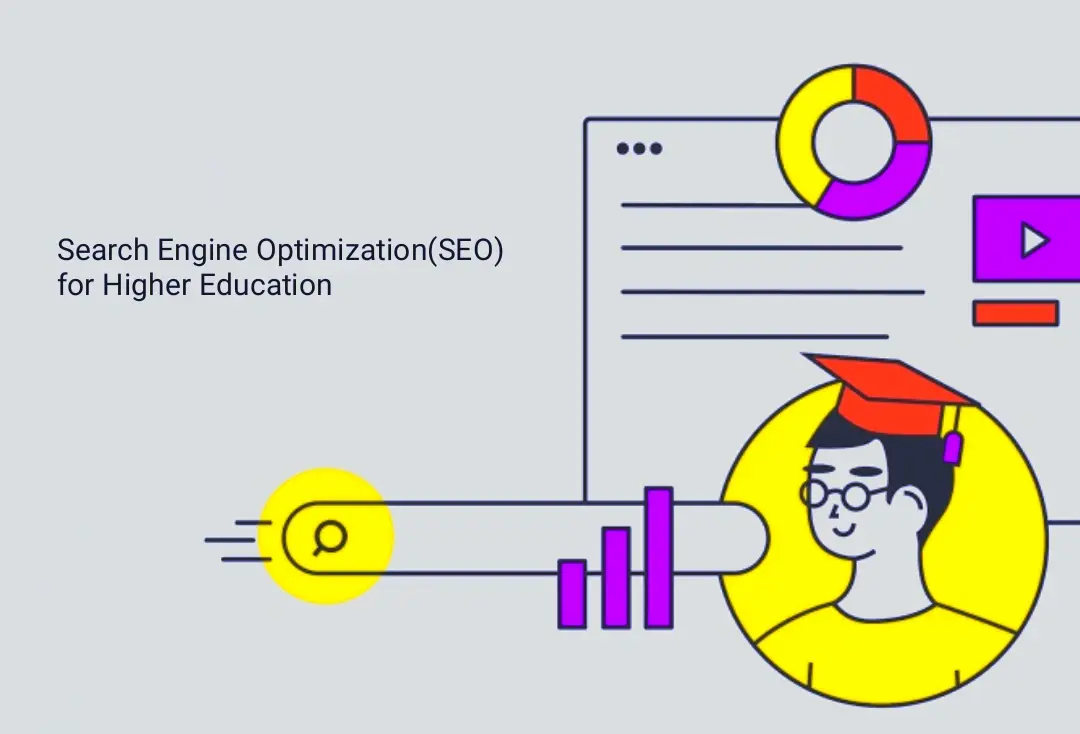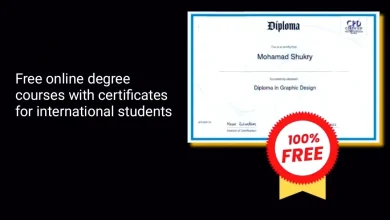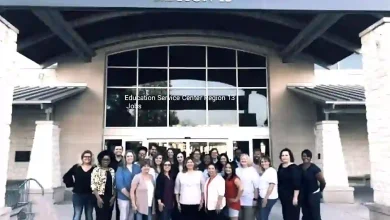Search Engine Optimization(SEO) for Higher Education: A Comprehensive Guide

Introduction
The digital landscape for higher education institutions has become increasingly competitive. Colleges and universities no longer rely on reputation and traditional marketing to attract students. Today’s online aStoday’sline presence is crucial for standing out in today’s internet-driven world. Search Engine Optimization (SEO) plays a pivotal role in ensuring that institutions of higher learning are visible to prospective students, parents, and other stakeholders. This blog post will explore the importance of SEO for higher education institutions, the best strategies, and actionable tips for success.
Why Search Engine Optimization is Important for Higher Education Institutions?
Table of Contents
In the modern education marketplace, students often begin their search for colleges and universities online. According to research, more than 80% of students use search engines to explore their education options, comparing programs, campuses, and costs. As a result, if your institution’s website is not easily found on Google or other search engines, you risk losing potential students to competitors.
Here are some key reasons why SEO is vital for higher education institutions:
- Increased Visibility: The higher your website ranks in search engine results, the more visible it will be to prospective students.
- Boost in Organic Traffic: SEO ensures your website attracts organic traffic, reducing reliance on paid advertisements.
- Enhanced Brand Credibility: High search engine rankings enhance the credibility and trustworthiness of your institution.
- Improved User Experience: SEO practices such as mobile optimization and faster loading times improve the user experience, which leads to better engagement.
Essential SEO Strategies for Higher Education Institutions
Higher education institutions must focus on several crucial areas to successfully implement an SEO strategy. These include keyword research, on-page SEO, technical SEO, off-page SEO, content creation, and local SEO.
Understanding the Search Behavior of Prospective Students
Keyword Research for Higher Education
Prospective students use different search queries when seeking educational programs. Effective keyword research involves identifying terms and phrases such as “top business schools,” “online master’s degrees,” or “college admissions requirements.” Tools like Google Keyword Planner, Ahrefs, and SEMrush can help institutions identify high-value keywords that reflect search intent and volume.
Long-Tail Keywords
Long-tail keywords are critical for higher education SEO. While short keywords like “engineering degree” are highly competitive, long-tail keywords like “best engineering degree for career growth” are more specific and have lower competition. By targeting long-tail keywords, universities can better meet the search intent of students at different stages in their decision-making process.
Understanding Search Intent
Prospective students have different types of search intent: informational (e.g., “What is computer science?”), navigational (e.g., “Stanford MBA program“), and transactional (e.g., “apply for an MBA program”). Crafting content that matches these intents is critical to capturing their attention at every funnel stage.
Keyword Research for Higher Education
Keyword research is the foundation of any successful SEO strategy. It helps identify what prospective students are searching for and tailors your content to meet their needs.
- Identify Core Keywords: Research core keywords related to your programs and services. Keywords such as “undergraduate business degree,” engineering programs,” or “online master’s education “are examples of terms that could attract prospective students.
- Long-Tail Keywords: These are specific phrases that target a niche audience, like” “est online or “affordable programs for working adults,” r, “and “affordable psychology programs near me.” Long-tail keywords typically have less competition and are easier to rank for.
- Competitor Analysis: Look at the keywords for which your competitors (other universities) rank. Use tools like SEMrush or Ahrefs to identify opportunities to outrank them.
- Seasonality and Trends: Pay attention to keyword trends and seasonality—for example, searches for “college applications “spike during certain times of the year.
On-Page SEO for Higher Education
Optimizing Meta Tags and Headers
Meta tags and headers play a crucial role in on-page SEO. Title tags must include relevant keywords to increase click-through rates. A well-optimized meta description should provide an enticing summary encouraging prospective students to click on your website.
Content Quality and Relevance
Creating quality, valuable content is a foundational aspect of SEO. Blog posts, program pages, and resource guides should answer prospective students’ common questions. Higher education websites can benefit from featuring student testimonials, faculty spotlights, alum success stories, and detailed program descriptions, all optimized with keywords.
Mobile Optimization
Today, many prospective students use mobile devices to research higher education programs. It is crucial to ensure that your website is mobile-friendly with a responsive design and fast loading times. Mobile optimization impacts user experience and SEO rankings, as Google prioritizes mobile-first indexing.
URL Structure and Internal Linking
A clean URL structure contributes to an SEO-friendly website. URLs should be readable, keyword-optimized, and relevant. Internal linking is also essential for navigation and keeping users engaged longer. Internal links help distribute page authority across your site and guide users toward important conversion pages, such as application forms or program information.
On-page SEO refers to optimizing your institution’s pages. Proper on-page optimization ensures that search engines can easily index and understand your content.
- Title Tags and Meta Descriptions: Every page should have a unique title tag and meta description, including your target keywords. The meta description briefly summarizes the content and encourages users to click the link.
- Headings (H1, H2, H3): Organize your content using headings and subheadings. Ensure the H1 tag contains the primary keyword and that other subheadings (H2, H3) are logically relevant and structured.
- URL Structure: Clean URLs with keywords perform better than long, confusing ones. For example, “www.university.edu/programs/online-business-degree/ “is much better than” “www.university.edu/12345/.” Internal Linking: Include internal links to other pages of your website, such as program details, application forms, or blog posts. Internal linking helps search engines understand your site’s structure and increases users’ time spent on it.
- Image Optimization: Use alt text for all images, which helps improve accessibility and allows search engines to understand the content of your photos. Compress image files for faster load times.
Technical SEO for Higher Education
Technical SEO involves optimizing your website’s backend structure so search engines can crawl and index it effectively.
- Mobile Optimization: Many students use mobile devices to research schools. Ensure that your website is mobile-friendly, with responsive design and easy navigation.
- Site Speed: Students will not wait for a slow website to load. Optimize your website by compressing images, browser caching, and minimizing HTTP requests.
- XML Sitemaps: Submit an XML sitemap to Google Search Console. This helps search engines understand your site’s structure and ensures all necessary pages are crawled.
- SSL Certificate: A secure website (HTTPS) is critical for ranking, as Google prefers secure sites. An SSL certificate ensures data transmission between users and your site is encrypted.
Off-Page SEO for Higher Education
Off-page SEO involves activities outside your website that impact your rankings, such as backlinking and social media engagement.
- Backlinks: Backlinks are one of the most important ranking factors. Focus on earning high-quality backlinks from reputable websites, education portals, and authoritative sources. Contact alum associations, education blogs, and academic institutions for link-building opportunities.
- Social Media: While social media signals are not a direct ranking factor, active social media profiles drive traffic to your website, improve brand awareness, and engage potential students. Ensure that your institution’s social media channels link back to the relevant pages of your website.
- Online Reviews: Positive reviews can boost your institution’s credibility. Encourage students, alums, and parents to leave reviews on Google, education platforms, and directories.
Content Marketing for Higher Education SEO
Creating High-Value Content
Content marketing can help institutions attract prospective students and drive conversions. Some effective content types include:
- Blogs: Write blogs answering common questions such as “How to apply for a student visa” or “Tips for writing a college application essay.”
- Guides: Create detailed guides like “Choosing the Right Major” or “Benefits of Studying Abroad.”
- Video Content: Videos showcasing campus tours, faculty interviews, or student testimonials can significantly impact decision-making.
Student-Centric Content
Producing content that addresses the concerns of prospective students is crucial. Address topics like “Career Outcomes After Graduation,” “Scholarships and Financial Aid,” and “Student Life at [Institution Name].” The content should be well-optimized, including keywords to improve search engine rankings.
Updating Existing Content
SEO is an ongoing process that requires content to be regularly updated. Outdated content may lose rankings over time, so periodically reviewing and updating pages with new information, statistics, and keywords can improve rankings and keep students engaged.
Content is the driving force behind SEO. Creating valuable, engaging content for higher education institutions that speaks to prospective students’ needs is essential for success. Here are several content strategies to consider:
Blog Posts and Articles
Maintain an active blog where you can publish helpful articles related to your institution. Examples of topics include:
- Campus Life: Share stories about student experiences, clubs, and organizations.
- Admissions: Provide detailed guides on how to apply, what documents are needed, and timelines.
- Academic Programs: Write in-depth content about specific programs, including benefits, career outcomes, and success stories from alums.
Student Testimonials and Case Studies
Showcasing success stories from current students or alums is one of the most effective ways to build trust with prospective students. Include video testimonials or case studies highlighting how the institution helped them succeed.
Video Content
Video content is increasingly popular and helps keep visitors on your site for longer, which improves SEO. Produce videos about:
- Campus tours
- Faculty introductions
- Program highlights
- Virtual open days
Resource Pages and FAQs
Create resource pages to answer common questions about your institution, such as financial aid, housing, tuition, and specific program details. This content helps your site rank for relevant search queries and improves user engagement.
Content for International Students
If your institution attracts international students, create specific content tailored to their needs. Topics could include visa applications, language requirements, and life as an international student.
Local SEO for Higher Education Institutions
Local SEO is essential for institutions that want to attract students from specific geographic areas. Here, you can optimize for local SEO:
Google My Business (GMB) Listing
Ensure your institution has an up-to-date Google My Business listing. Include:
- The correct name, address, and phone number (NAP)
- High-quality images of your campus
- Accurate hours of operation
- Links to your website and social media profiles
Encourage students and faculty to leave reviews on Google, as positive reviews can boost your local rankings.
Local Keywords
Incorporate local keywords in your content, such as” “est universities in [City/State].” This helps search engines understand your geographical focus and makes it easier for local students to find you.
Local Backlinks
Build relationships with local businesses, news outlets, and organizations to earn backlinks from local sources. Local backlinks carry significant weight for local SEO.
Campus Location Pages
If your institution has multiple campuses, create dedicated landing pages for each. These pages should include location-specific keywords, contact information, and a campus map.
Measuring SEO Success in Higher Education
Measuring the success of your SEO efforts is crucial to understand what’s working and where improvements are needed. Key metrics to track include:
Organic Traffic
Use Google Analytics to track the volume of traffic coming from search engines. Analyze traffic trends over time and identify which pages drive the most visitors.
Keyword Rankings
Tools like Ahrefs, SEMrush, or Moz can help you monitor your keyword rankings. Focus on improving rankings for high-value keywords, such as program-specific or location-based terms, that drive conversions.
Bounce Rate and Time on Page
These metrics help you understand how users are interacting with your content. A high bounce rate may indicate that the content needs to meet user expectations. Conversely, a higher time on the page suggests that users find your content engaging.
Conversion Rate
Ultimately, SEO should lead to conversions, whether application submission, a request for more information, or registration for a virtual campus tour. Track these conversions using Google Analytics or your institution’s CRM.
Backlinks and Domain Authority
Keep track of the number of backlinks pointing to your site and your domain authority (DA) score. More backlinks from high-quality sources will boost your institution’s credibility and ranking potential.
Common SEO Challenges in Higher Education and How to Overcome Them
SEO in higher education presents some unique challenges. Here are some common hurdles and how to address them:
Multiple Decision Makers
Universities often have multiple departments managing their content, which can lead to a lack of consistency. To overcome this, establish a clear SEO strategy that all departments follow and assign a dedicated SEO manager to oversee and implement the plan.
Outdated Content
Universities may have vast outdated or irrelevant content that no longer serves students. Conduct regular content audits to remove or update old content, ensuring your website remains relevant and engaging.
Mobile Experience
Many students use mobile devices to search for colleges and universities. Ensure your website is fully optimized for mobile with fast load times and easy-to-navigate menus.
Conclusion
SEO for higher education institutions is a long-term investment that yields significant returns. By implementing the strategies outlined in this guide, your institution can improve its online visibility, attract more students, and drive conversions. Whether you’re just starting with SEO or looking to refine your strategy, the key is to provide valuable, user-centered content and follow best practices for on-page, technical, and local SEO.
By staying updated with the latest SEO trends and continuously optimizing your website, your institution can remain competitive in the ever-evolving digital landscape of higher education.
>>Digital signage for education.



